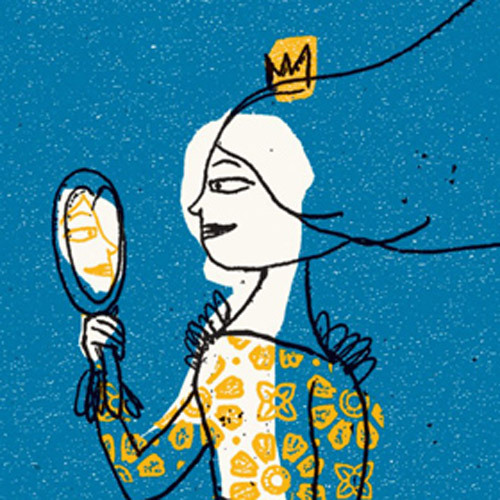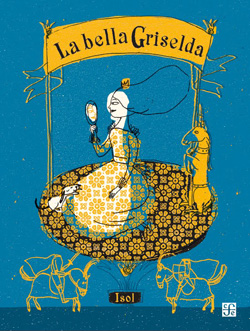< Back to posts
Isol
Argentina

Isol (Marisol Misenta) is an Argentine pop singer, illustrator and picturebook maker. Since her first book was published in 1997, she's produced an impressive body of work and has won many awards. For her contribution to children's and young adult literature, Isol received the prestigious Astrid Lindgren Memorial Award in 2013.
In this post, Isol talks about the creation of ‘La bella Griselda’ (Beautiful Griselda) and she shares some wonderful development work. This striking picturebook about the pitfalls of narcissism was originally published in Spanish by Fondo de Cultura Económica.
Isol: This book was born from a popular phrase which is related to the idea of metaphorically losing one's head over someone. The literal illustration of this phrase, which is like a compliment when said of someone ('she is so beautiful that everyone loses their head over her'), was the trigger for the entire story of Princess Griselda. The image of this situation seemed disturbing and comic to me, with the heads of the suitors rolling around her.
What would you do with so many heads? Collect them? Something about the values of the perfect princess, of conquests for the ego, seemed to be stripped bare after continually drawing and taking to the extreme the situation where beauty never brings real happiness to its owner.
The princess starts to wish she could find someone who doesn't succumb to her beauty, so she calls to a nearly-blind prince who will last at least a couple of hours...
... until the moment arrives in which the protagonist herself happily loses her own head when she becomes a mother.
The sketches were done in pencil and I kept showing others the progression of my drawing. I changed parts of the story as time went on after conversations with my friends and colleagues.
As you can see, my early sketches are very similar to some of the final illustrations.
The pages after Griselda loses her head were initially the most work for me, as finishing a story is always the most difficult part. Leaving a girl without a mother could be very sad, so I had to be delicate with the final illustrations.
The final phrase of the book is difficult to translate into some languages because it's a play on words that only works in Latin languages (‘the daughter loves to assemble jigsaw puzzles’... the word for ‘jigsaw puzzles’ is literally ‘break heads’ in Spanish). So for the English version, I had to find another way.
With my books, I always work a lot on the text so that it's concise and powerful – and I do the same with the drawings.
Once I had finished the sketches, I took quite a while to find the right visual language for the book. I didn't have faith in the flowing and simple lines of the sketches, and I wanted to research other possibilities.
For example, I used ink sgraffito and oil pastels, but it started to lose fluidity and looked overdone. In the end, I returned to a line similar to that of the sketches, in which the expression of the characters was the most clear. But I had trouble developing the final drawings and their expression. I ended up working with pencil and pen on tracing paper.
Another challenge was having to draw scenes in which a lot was happening – and scenes with many people, which was something I hadn't done in my previous books. It was clear that I had to draw the interior of the palace where Griselda lived, or at least evoke it somehow. I worked with pastel on paper, then took photos and tried them out.
There's so many options! Working with the computer can be a never-ending story; I had to simplify matters. I think that it was for that reason that I finally decided to use only four colours in the entire book, and only Pantone colours, which are colours from a special international palette.
I've loved using solid colours ever since I did serigraphy (silkscreens) and etching, where the colours are applied separately. I played with the transparencies and overlapping of the colours, and with the colours of the lines of the characters. I also had to learn how to work with separate inks; it took me a while but it was very interesting, and having those possibilities and limitations resolved other questions for me. I worked by using channels in Photoshop – not the standard CMYK colours.
I decided the colours were going to be blue, orange, black and pale yellow. And for the first time, I used patterns taken from origami papers to make the costumes and the castle decorations, processing them and putting them into the drawing.
I was also influenced by the floral designs of medieval tapestries, which were a great reference point as they've fascinated me for some time. In fact, I used a composition similar to that of the 15th century tapestry, ‘The Lady and the Unicorn’ for the front cover.
I also took photos of some mosaics that I have on the floor of my house and I used them on the floor of Griselda's castle.
The great Paolo Uccello was a reference point for the knights.
Having the text included in the images meant I had to think about the design as a whole and make sure that the background didn't make it difficult to read.
And in the countryside background when Griselda is in the carriage, there are real castles. I needed something that was weighty and concrete for the buildings – something that wasn't light or movable like my drawings, but heavier. So I put real castles in the background of the illustration to give it strength.
Here you can see the development of a few of my other illustrations. There's early and final versions of the medieval joust and of Griselda feeling bored. I really think that thanks to the time I dedicated to this project, the images improved a lot and the book has taken on a coherent and strong aesthetic, without losing any of its freshness or humour.
Illustrations © Isol. Post translated by Gengo and edited by dPICTUS.
La bella Griselda /
Beautiful Griselda
Isol
Fondo de Cultura Económica, Mexico, 2010
Griselda is so beautiful that her suitors literally lose their heads! Not only does she cause anyone who looks at her to lose his head – she collects the lost heads, oblivious to the fact that everyone is terrified of her.
One day, Griselda finds a prince so short-sighted that he's able to be with her for a short while (until the inevitable happens). But they're together long enough to have a baby – and for the first time, Griselda learns what it's like to lose your head for someone you love.




























